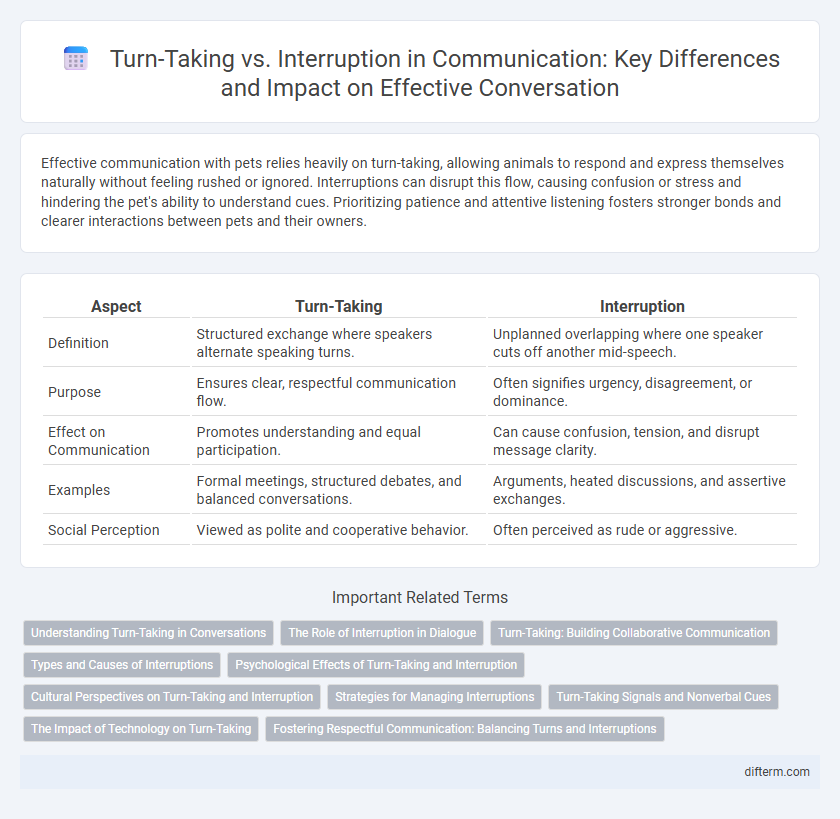Effective communication with pets relies heavily on turn-taking, allowing animals to respond and express themselves naturally without feeling rushed or ignored. Interruptions can disrupt this flow, causing confusion or stress and hindering the pet's ability to understand cues. Prioritizing patience and attentive listening fosters stronger bonds and clearer interactions between pets and their owners.
Table of Comparison
| Aspect | Turn-Taking | Interruption |
|---|---|---|
| Definition | Structured exchange where speakers alternate speaking turns. | Unplanned overlapping where one speaker cuts off another mid-speech. |
| Purpose | Ensures clear, respectful communication flow. | Often signifies urgency, disagreement, or dominance. |
| Effect on Communication | Promotes understanding and equal participation. | Can cause confusion, tension, and disrupt message clarity. |
| Examples | Formal meetings, structured debates, and balanced conversations. | Arguments, heated discussions, and assertive exchanges. |
| Social Perception | Viewed as polite and cooperative behavior. | Often perceived as rude or aggressive. |
Understanding Turn-Taking in Conversations
Turn-taking in conversations ensures smooth communication by allowing speakers to alternate roles without overlapping speech, promoting clarity and mutual understanding. Effective turn-taking relies on social cues, such as intonation, eye contact, and pauses, which signal when one person is finished and another can begin speaking. Interruptions disrupt this flow, often leading to misunderstandings and decreased conversational quality.
The Role of Interruption in Dialogue
Interruption plays a complex role in dialogue, serving both as a signal of engagement and as a potential barrier to effective communication. In conversations, strategic interruptions can highlight enthusiasm or emphasize points, while frequent or untimely interruptions may disrupt conversational flow and inhibit mutual understanding. Understanding the balance between turn-taking and interruption is essential for fostering dynamic yet respectful interactions in both personal and professional contexts.
Turn-Taking: Building Collaborative Communication
Turn-taking in communication fosters a collaborative environment by allowing all participants to contribute their ideas without being overshadowed. Structured turn-taking enhances understanding, reduces misunderstandings, and promotes active listening among team members. Effective turn-taking strategies support equal participation, leading to more productive and inclusive conversations.
Types and Causes of Interruptions
Interruptions in communication can be categorized into cooperative and intrusive types, where cooperative interruptions aim to contribute or clarify, while intrusive ones disrupt the speaker's flow. Common causes of interruptions include eagerness to respond, dominance assertion, and cultural communication styles that influence conversational rhythm. Understanding these types and causes helps improve turn-taking by fostering more respectful and effective dialogue dynamics.
Psychological Effects of Turn-Taking and Interruption
Turn-taking in communication fosters a sense of respect and attentiveness, enhancing mutual understanding and reducing anxiety. In contrast, frequent interruptions can increase stress levels, diminish self-esteem, and create feelings of frustration or exclusion. Psychological studies reveal that balanced turn-taking promotes cooperation and positive social interactions, while interruptions often lead to misunderstandings and conflict escalation.
Cultural Perspectives on Turn-Taking and Interruption
Cultural perspectives on turn-taking and interruption reveal significant variations in conversational norms across societies. In some cultures, overlapping speech and frequent interruptions signify engagement and enthusiasm, while others value clear pauses and orderly exchanges as signs of respect and attentiveness. Understanding these cultural differences enhances effective communication and reduces misunderstandings in multicultural interactions.
Strategies for Managing Interruptions
Effective strategies for managing interruptions during communication include establishing clear turn-taking cues such as hand gestures or verbal signals to maintain conversational flow. Setting explicit ground rules at the beginning of discussions can minimize disruptions and promote respectful exchanges. Utilizing active listening techniques and pausing briefly before responding helps speakers regain control while ensuring interruptions do not impede message clarity.
Turn-Taking Signals and Nonverbal Cues
Turn-taking signals in communication often involve subtle nonverbal cues such as eye contact, head nods, and shifts in body posture, which indicate a speaker's intention to yield or retain the conversational floor. Pauses and changes in vocal tone also serve as critical auditory signals that help regulate the flow of dialogue without verbal interruption. Understanding these signals enhances conversational dynamics by reducing overlap and promoting respectful, smooth exchanges between participants.
The Impact of Technology on Turn-Taking
Technology has significantly altered traditional turn-taking dynamics by enabling asynchronous communication and introducing new modalities such as instant messaging and video calls. Digital platforms often reduce nonverbal cues critical for smooth turn exchanges, leading to increased instances of interruptions and overlapping speech. These shifts challenge conversational norms, requiring users to adapt communication strategies to maintain clarity and engagement in technologically mediated interactions.
Fostering Respectful Communication: Balancing Turns and Interruptions
Effective communication relies on balancing turn-taking and interruptions to foster respect and understanding. Prioritizing active listening and acknowledging conversational cues helps maintain smooth exchanges and minimizes disruptions. Encouraging respectful turn-taking enhances clarity, reduces conflicts, and supports collaborative dialogue in both personal and professional settings.
turn-taking vs interruption Infographic

 difterm.com
difterm.com